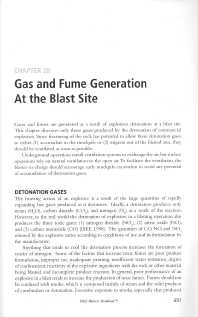Mining Publication: Gas and Fume Generation at the Blast Site
Original creation date: January 2011
Gases and fumes are generated as a result of explosives detonation at a blast site. This chapter discusses only those gases produced by the detonation of commercial explosives. Since fracturing of the rock has potential to allow these detonation gases to either (1) accumulate in the muckpile or (2) migrate out of the blasted area, they should be ventilated as soon as possible. Underground operations install ventilation systems to exchange the air, but surface operations rely on natural ventilation to the open air. To facilitate the ventilation, the blaster-in-charge should encourage early muckpile excavation to avoid any potential of accumulation of detonation gases.
Authors: RJ Mainiero
Book Chapter - January 2011
NIOSHTIC2 Number: 20039323
ISEE Blasters' Handbook, 18th edition. Cleveland, OH: International Society of Explosives Engineers, Inc., 2011 Jan; :657-663
See Also
- Advances in Grid-Based Numerical Modeling Techniques for Improving Gas Management in Coal Mines
- Behavior of Nitrogen Oxides in the Product Gases from Explosive Detonations
- Blasting and Explosives
- Commercial-Quality Gas From a Multipurpose Borehole Located in the Pittsburgh Coalbed
- Gas Sorption and Transport in Coals: A Poroelastic Medium Approach
- The Limiting Oxygen Concentration and Flammability Limits of Gases and Gas Mixtures
- Performance of RETIMET Metal Foam Vents on Explosion-Proof Enclosures
- Prediction of Longwall Methane Emissions: An Evaluation of the Influence of Mining Practices on Gas Emissions and Methane Control Systems
- Reconciling Longwall Gob Gas Reservoirs and Venthole Production Performances Using Multiple Rate Drawdown Well Test Analysis
- A Technique for Measuring Toxic Gases Produced by Blasting Agents
- Page last reviewed: 7/2/2015
- Page last updated: 7/2/2015
- Content source: National Institute for Occupational Safety and Health, Mining Program


 ShareCompartir
ShareCompartir
